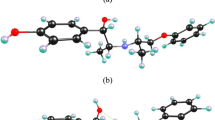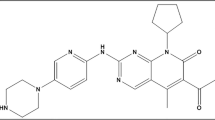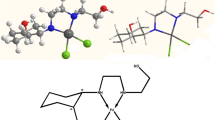Abstract
Flavonoids have potential applications in the nutraceutical, medicinal, pharmaceutical and cosmetic fields. The binding of flavonoids with DNA could unravel essential information required for the design of novel and effective chemical agents. The present paper describes the interaction of a flavonoid and a potent anticancer drug, galangin (GAL) with calf thymus DNA (ct-DNA) by fluorescence, UV absorption, melting studies, viscosity measurements and molecular docking studies. A hyperchromic effect was noticed in the absorption spectra of ct-DNA in the presence of the GAL system, indicating the presence of a groove mode of binding. Furthermore, GAL persuaded the minor changes in ct-DNA viscosity, indicating a non-intercalative mode of binding. Fluorescence studies revealed that the GAL quenched the fluorescence intensity of ct-DNA-Hoechst, thereby indicating the interaction between GAL and ct-DNA. Fluorescence results obtained at 298, 308 and 318 K revealed that the fluorescence quenching of ct-DNA-Hoechst-GAL occurred through the static quenching mechanism. Thermodynamic parameters for ct-DNA-Hoechst-GAL were computed and suitable conclusions were drawn. The changes noticed in the conformation of ct-DNA upon interaction with GAL were evaluated in terms of molar ellipticity. It indicated a plausible interaction between ct-DNA and GAL. The molecular docking studies also confirmed the groove mode of binding in the ct-DNA-GAL system. Thus, this work helped to unravel the binding mechanism between GAL and ct-DNA.
Graphical abstract












Similar content being viewed by others
Data Availability
The datasets generated during and/or analyzed during the current study are available from the corresponding author on reasonable request.
References
Dickerson RE, Kopka ML (1985) Nuclear overhauser data and stereochemical considerations suggest that netropsin binds symmetrically within the minor groove of poly(D a) opoly (d t), forming hydrogen bonds with both strands of the double helix. J Biomol Struct Dyn 3:423–431. https://doi.org/10.1080/07391102.1985.10508431
Shaghaghi M, Dehghan G, Jouyban A et al (2014) Studies of interaction between terbium(III)-deferasirox and double helix DNA by spectral and electrochemical methods. Spectrochim Acta A Mol Biomol Spectrosc 120:467–472
Vijayabharathi R, Sathyadevi P, Krishnamoorthy P et al (2012) Interaction studies of resistomycin from Streptomyces aurantiacus AAA5 with calf thymus DNA and bovine serum albumin. Spectrochim Acta A Mol Biomol Spectrosc 89:294–300. https://doi.org/10.1016/j.saa.2011.12.072
Isobe H, Fujino T (2014) Triazole-linked analogues of DNA and RNA (TLDNA and TLRNA): Synthesis and functions. Chem Rec 14:41–51. https://doi.org/10.1002/tcr.201300023
Panche AN, Diwan AD, Chandra SR (2016) Flavonoids: an overview. J Nutr Sci 5:1–15. https://doi.org/10.1017/jns.2016.41
Khan J, Kumar Deb P, Priya S et al (2021) Dietary flavonoids: cardioprotective potential with antioxidant effects and their pharmacokinetic, toxicological and therapeutic concerns. Molecules. https://doi.org/10.3390/molecules26134021
Yousefi M, Shadnoush M, Sohrabvandi S et al (2021) Encapsulation systems for delivery of flavonoids: A review. Biointerface Res Appl Chem 11:13934–13951. https://doi.org/10.33263/BRIAC116.1393413951
Chien ST, Der SM, Lee YC et al (2015) Galangin, a novel dietary flavonoid, attenuates metastatic feature via PKC/ERK signaling pathway in TPA-treated liver cancer HepG2 cells. Cancer Cell Int 15:1–11. https://doi.org/10.1186/s12935-015-0168-2
Palchaudhuri R, Hergenrother PJ (2007) DNA as a target for anticancer compounds: methods to determine the mode of binding and the mechanism of action. Curr Opin Biotechnol 18:497–503. https://doi.org/10.1016/J.COPBIO.2007.09.006
Sunita M, Anupama B, Ushaiah B, Kumari CG (2017) Synthesis, characterization, DNA binding and cleavage studies of mixed-ligand copper (II) complexes. Arab J Chem 10:S3367–S3374. https://doi.org/10.1016/J.ARABJC.2014.01.017
Morawska K, Popławski T, Ciesielski W, Smarzewska S (2018) Electrochemical and spectroscopic studies of the interaction of antiviral drug Tenofovir with single and double stranded DNA. Bioelectrochemistry 123:227–232. https://doi.org/10.1016/j.bioelechem.2018.06.002
Khandar AA, Mirzaei-Kalar Z, Shahabadi N et al (2022) Antimicrobial, cytotoxicity, molecular modeling and DNA cleavage/binding studies of zinc-naproxen complex: switching DNA binding mode of naproxen by coordination to zinc ion. J Biomol Struct Dyn 40:4224–4236. https://doi.org/10.1080/07391102.2020.1854858
Morawska K, Ciesielski W, Smarzewska S (2021) First electroanalytical studies of methoxyfenozide and its interactions with dsDNA. J Electroanal Chem 882:115030–115036. https://doi.org/10.1016/j.jelechem.2021.115030
Rauf S, Gooding JJ, Akhtar K et al (2005) Electrochemical approach of anticancer drugs–DNA interaction. J Pharm Biomed Anal 37:205–217. https://doi.org/10.1016/J.JPBA.2004.10.037
Farooqi SI, Arshad N, Channar PA et al (2018) Synthesis, theoretical, spectroscopic and electrochemical DNA binding investigations of 1, 3, 4-thiadiazole derivatives of ibuprofen and ciprofloxacin: Cancer cell line studies. J Photochem Photobiol B Biol 189:104–118. https://doi.org/10.1016/j.jphotobiol.2018.10.006
Mukherjee A, Ghosh S, Ghosh S et al (2021) Molecular recognition of synthesized halogenated chalcone by calf thymus DNA through multispectroscopic studies and analysis the anti-cancer, anti-bacterial activity of the compounds. J Mol Liq 337:116504–16518. https://doi.org/10.1016/j.molliq.2021.116504
Parveen M, Aslam A, Siddiqui S et al (2022) Structure elucidation, DNA binding and molecular docking studies of natural compounds isolated from Crateva religiosa leaves. J Mol Struct 1251:131976. https://doi.org/10.1016/J.MOLSTRUC.2021.131976
Ponkarpagam S, Mahalakshmi G, Vennila KN, Elango KP (2020) Multi-spectroscopic, voltammetric and molecular docking studies on binding of anti-diabetic drug rosigiltazone with DNA. Spectrochim Acta A Mol Biomol Spectrosc 234:118268. https://doi.org/10.1016/j.saa.2020.118268
Siddiqui S, Mujeeb A, Ameen F et al (2021) Investigating the mechanism of binding of nalidixic acid with deoxyribonucleic acid and serum albumin: a biophysical and molecular docking approaches. J Biomol Struct Dyn 39:570–585. https://doi.org/10.1080/07391102.2020.1711808
Mukherjee A, Singh B (2017) Binding interaction of pharmaceutical drug captopril with calf thymus DNA: a multispectroscopic and molecular docking study. J Lumin 190:319–327. https://doi.org/10.1016/j.jlumin.2017.05.068
Arif R, Nayab PS, Akrema et al (2019) Investigation of DNA binding and molecular docking propensity of phthalimide derivatives: in vitro antibacterial and antioxidant assay. J Anal Sci Technol 10:1–9. https://doi.org/10.1186/s40543-019-0177-1
Barton JK, Raphael AL (2002) Photoactivated stereospecific cleavage of double-helical DNA by cobalt(III) complexes. J Am Chem Soc 106:2466–2468. https://doi.org/10.1021/ja00320a058
Shahabadi N, Falsafi M, Maghsudi M (2017) DNA-binding study of anticancer drug cytarabine by spectroscopic and molecular docking techniques. Nucleos Nucleot Nucl Acids 36:49–65. https://doi.org/10.1080/15257770.2016.1218021
Pasternack RF, Gibbs EJ, Villafranca JJ, Villafranca JJ (1983) Interactions of Porphyrins with Nucleic Acids. Biochemistry 22:5409–5417. https://doi.org/10.1021/bi00292a024
Rahban M, Divsalar A, Saboury AA, Golestani A (2010) Nanotoxicity and Spectroscopy Studies of Silver Nanoparticle: Calf Thymus DNA and K562 as Targets. J Phys Chem C 114:5798–5803. https://doi.org/10.1021/jp910656g
Afrin S, Rahman Y, Sarwar T et al (2017) Molecular spectroscopic and thermodynamic studies on the interaction of anti-platelet drug ticlopidine with calf thymus DNA. Spectrochim Acta A Mol Biomol Spectrosc 186:66–75. https://doi.org/10.1016/j.saa.2017.05.073
Nyarko E, Hanada N, Habib A, Tabata M (2004) Fluorescence and phosphorescence spectra of Au(III), Pt(II) and Pd(II) porphyrins with DNA at room temperature. Inorganica Chim Acta 357:739–745. https://doi.org/10.1016/j.ica.2003.08.023
Shi JH, Liu TT, Jiang M et al (2015) Characterization of interaction of calf thymus DNA with gefitinib: Spectroscopic methods and molecular docking. J Photochem Photobiol B Biol 147:47–55. https://doi.org/10.1016/j.jphotobiol.2015.03.005
Mukherjee A, Mondal S, Singh B (2017) Spectroscopic, electrochemical and molecular docking study of the binding interaction of a small molecule 5H-naptho[2,1-f][1,2] oxathieaphine 2,2-dioxide with calf thymus DNA. Int J Bio Macromol 101:527–535. https://doi.org/10.1016/j.ijbiomac.2017.03.053
Liu BM, Zhang J, Liu Y et al (2015) Multi-spectroscopic methods investigation on the interaction of tenoxicam with DNA. Luminescence 30:1313–1317. https://doi.org/10.1002/bio.2899
Chaves OA, Fernandes TVA, de Melos JLR et al (2020) Elucidation of the interaction between human serum albumin (HSA) and 3,4-methylenedioxyde-6-iodo-benzaldehyde-thiosemicarbazone, a potential drug for Leishmania amazonensis: Multiple spectroscopic and dynamics simulation approach. J Mol Liq 310:1–9. https://doi.org/10.1016/j.molliq.2020.113117
Mirzaei-Kalar Z (2018) In vitro binding interaction of atorvastatin with calf thymus DNA: multispectroscopic, gel electrophoresis and molecular docking studies. J Pharm Biomed Anal 161:101–109. https://doi.org/10.1016/j.jpba.2018.08.033
Guan Y, Zhou W, Yao X et al (2006) Determination of nucleic acids based on the fluorescence quenching of Hoechst 33258 at pH 4.5. Anal Chim Acta 570:21–28
Khajeh MA, Dehghan G, Dastmalchi S et al (2018) Spectroscopic profiling and computational study of the binding of tschimgine: A natural monoterpene derivative, with calf thymus DNA. Spectrochim Acta A Mol Biomol Spectrosc 192:384–392. https://doi.org/10.1016/j.saa.2017.11.042
Lakowicz JR (1999) Quenching of Fluorescence. Princ Fluoresc Spectrosc 237–265. https://doi.org/10.1007/978-1-4757-3061-6_8
Abdelhameed AS, Bakheit AH, AlRabiah HK et al (2019) Molecular interactions of AL3818 (anlotinib) to human serum albumin as revealed by spectroscopic and molecular docking studies. J Mol Liq 273:259–265. https://doi.org/10.1016/j.molliq.2018.10.025
Lakowicz JR (1999) Protein Fluorescence. Princ Fluoresc Spectrosc 445–486. https://doi.org/10.1007/978-1-4757-3061-6_16
Nanda RK, Sarkar N, Banerjee R (2007) Probing the interaction of ellagic acid with human serum albumin: A fluorescence spectroscopic study. J Photochem Photobiol A Chem 192:152–158. https://doi.org/10.1016/j.jphotochem.2007.05.018
Eftink MR, Ghiron CA (1981) Fluorescence quenching studies with proteins. Anal Biochem 114:199–227. https://doi.org/10.1016/0003-2697(81)90474-7
Ross PD, Subramanian S (1981) Thermodynamics of Protein Association Reactions: Forces Contributing to Stability. Biochemistry 20:3096–3102. https://doi.org/10.1021/BI00514A017
Kou SB, Lou YY, Zhou KL et al (2019) In vitro exploration of interaction behavior between calf thymus DNA and fenhexamid with the help of multi-spectroscopic methods and molecular dynamics simulations. J Mol Liq 296:112067. https://doi.org/10.1016/j.molliq.2019.112067
Tao M, Zhang G, Pan J, Xiong C (2016) Deciphering the groove binding modes of tau-fluvalinate and flumethrin with calf thymus DNA. Spectrochim Acta A Mol Biomol Spectrosc 155:28–37. https://doi.org/10.1016/j.saa.2015.11.006
Ameen F, Siddiqui S, Jahan I et al (2022) Studying the interaction of scopolamine with calf-thymus DNA: An in-vitro and in-silico approach and genotoxicity. Spectrochim Acta A Mol Biomol Spectrosc 265:120391. https://doi.org/10.1016/J.SAA.2021.120391
Shahabadi N, Shiri F, Khodarahmi R (2022) A Cu(I) complex groove binder with a high affinity towards DNA denaturation. J Mol Liq 345:117904. https://doi.org/10.1016/J.MOLLIQ.2021.117904
Nayab PS, Pulaganti M, Chitta SK, Rahisuddin (2016) Multi-spectroscopic and molecular docking studies on the interaction of new phthalimides with calf-thymus DNA: In vitro free radical scavenging activities. Spectrosc Lett 49:108–117. https://doi.org/10.1080/00387010.2015.1095769
Sarwar T, Rehman SU, Husain MA et al (2015) Interaction of coumarin with calf thymus DNA: Deciphering the mode of binding by in vitro studies. Int J Biol Macromol 73:9–16. https://doi.org/10.1016/j.ijbiomac.2014.10.017
Shahabadi N, Ghaffari L, Mardani Z, Shiri F (2022) Experimental and Molecular Docking Studies on the Interaction of a Water-Soluble Pd(II) Complex Containing β-Amino Alcohol with Calf Thymus DNA. Biol Trace Elem Res 200:1988–2000. https://doi.org/10.1007/s12011-021-02803-1
Acknowledgements
The authors thank the authorities of USIC, Karnatak University, Dharwad for providing the necessary facilities to carry out this research work. The authors also thank the UPE-FAR I, DST-PURSE-II program for providing the facility of Schrodinger software suit to perform the molecular docking studies.
Author information
Authors and Affiliations
Contributions
Contributed Authors–Roopa Naik and J. Seetharamappa. All authors contributed to the study conception and design. Material preparation, data collection and analysis were performed by Roopa Naik. The first draft of the manuscript was written by Roopa Naik. Manuscript revision and experimental platform was contributed by J. Seetharamappa. All authors read and approved the final manuscript.
Corresponding author
Ethics declarations
Ethical Approval
Not applicable.
Consent to Participate
Not applicable.
Consent for Publication
Not applicable.
Conflicts of Interest
The authors declare they have no competing interests.
Additional information
Publisher's Note
Springer Nature remains neutral with regard to jurisdictional claims in published maps and institutional affiliations.
Highlights
• The exposure of bases pairs of ct-DNA to GAL was due to non-covalent interaction
• Fluorescence intensity of ct-DNA-Hoechst was quenched upon binding with GAL
• GAL interacted to ct-DNA by static quenching mechanism
• Viscosity, melting, probe binding assay, CD and docking studies confirmed the interaction and ruled out the intercalative mode of binding
• Molecular and biological processes of ct-DNA-GAL system was studied in vitro by theoretical and experimental methods
Rights and permissions
Springer Nature or its licensor holds exclusive rights to this article under a publishing agreement with the author(s) or other rightsholder(s); author self-archiving of the accepted manuscript version of this article is solely governed by the terms of such publishing agreement and applicable law.
About this article
Cite this article
Naik, R., Seetharamappa, J. In Vitro and Computational Approaches to Untangle the Binding Mechanism of Galangin with Calf Thymus DNA. J Fluoresc 33, 13–24 (2023). https://doi.org/10.1007/s10895-022-03033-x
Received:
Accepted:
Published:
Issue Date:
DOI: https://doi.org/10.1007/s10895-022-03033-x




